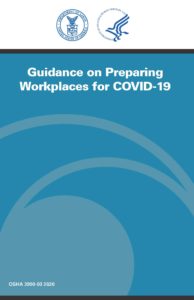
Guidance on Preparing Workplaces for COVID-19
March 20, 2020
Federal OSHA has published, Guidance on Preparing Workplaces for COVID-19, a PDF brochure filled with tips that may be helpful for organizations wondering how to maintain operations during this time.
Note: Most workplaces in Washington fall under the state Department of Safety & Health (DOSH). OSHA is the federal equivalent, overseeing workplace safety in many states. We are sharing this advice with you because the “…guidance is advisory in nature and informational in content. It is not a standard or a regulation, and it neither creates new legal obligations nor alters existing obligations…”
Impacts of COVID-19 and basic steps to protect and support employees
OSHA foresees three main types of impact to workplaces, many of which are already being seen in our state:
- Absenteeism, due to current or suspected illness, or the need to care for family members
- Changes in patterns of commerce, such as reduced spending or shopping at off hours
- Interrupted supply/delivery, as shipments from areas with COVID-19 outbreaks are impacted
Next OSHA suggests a series of workplace plans and policies. Again, with Washington ahead of most of the nation, many workplaces here have already adopted some or all of these:
- Develop an Infectious Disease Preparedness and Response Plan
- Prepare to Implement Basic Infection Prevention Measures
- Develop…Prompt Identification and Isolation of Sick People
- Communicate (to employees) about Workplace Flexibilities and Protections
Workplace Controls to Reduce COVID-19 Exposure
Next, OSHA introduces a series of controls that can be used to reduce exposure to COVID-19, understanding that elimination of risk may not be possible. This pamphlet lists four key areas of Workplace Control:
Engineering Controls
These are physical solutions such as air filters, higher ventilation rates, or plastic barriers. Drive through or walk-up windows for service – instead of allowing customers inside the workplace – also fall into this category. OSHA states that engineering controls can be very effective because they don’t rely on worker behaviour.
Administrative Controls
Again, many of you are probably practicing the first administrative control – encouraging sick employees to stay at home. But what about establishing alternating workdays or creating shifts, so that less employees are on-site at the same time? Administrative controls such as these require employees or the employer to take action or change their behaviour or policies.
Safe Work Practices
When it comes to COVID-19, safe work practices are all about personal hygiene. OSHA mentions tissues, hand washing, sanitizers and disinfectants, plus disposable and no-touch items, as key items needed to promote hygiene at this time.
Personal Protective Equipment (PPE)
PPE is listed last and OSHA states that “engineering and administrative controls are considered more effective in minimizing exposure to (COVID-19).” Of course, if PPE is used, it must be fitted and refitted for each worker, used consistently, and then properly cleaned or disposed of. In short, PPE has many additional considerations that don’t apply to the controls listed above.
How much risk do your workers have to COVID-19?
OSHA gives four levels of risk for COVID-19 exposure: Very high, High, Medium, and Lower. Most workers outside healthcare settings are in the lower or medium categories.
Lower risk employees can benefit from basic engineering and administrative controls, but do not need additional PPE specifically for COVID-19.
Medium risk employees can benefit from enhanced administrative controls, such as “drive-through windows, phone-based communication, (and) telework.” PPE may be required.
The brochure also contains detailed guidance for High and Very High-risk settings.
You can find the brochure, which is Publication 3990, plus other employer resources related to COVID-19 at https://www.osha.gov/SLTC/covid-19/.
